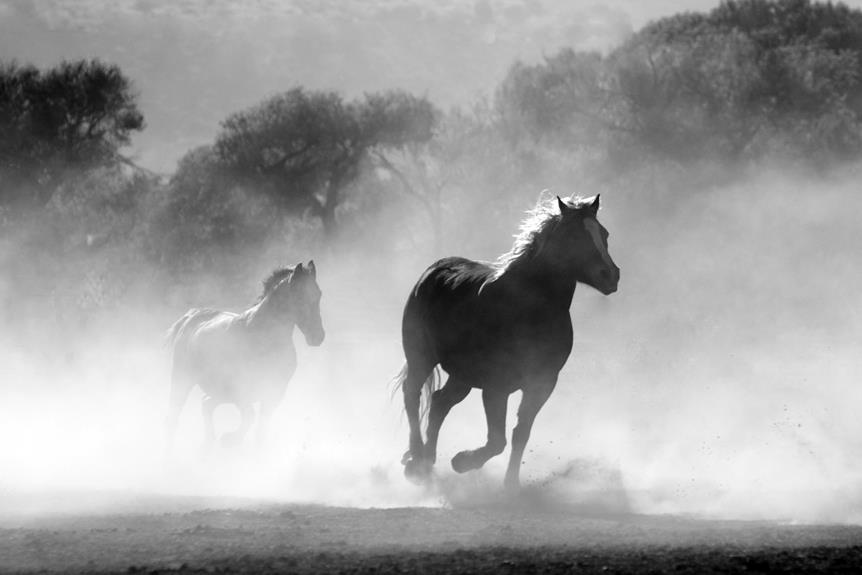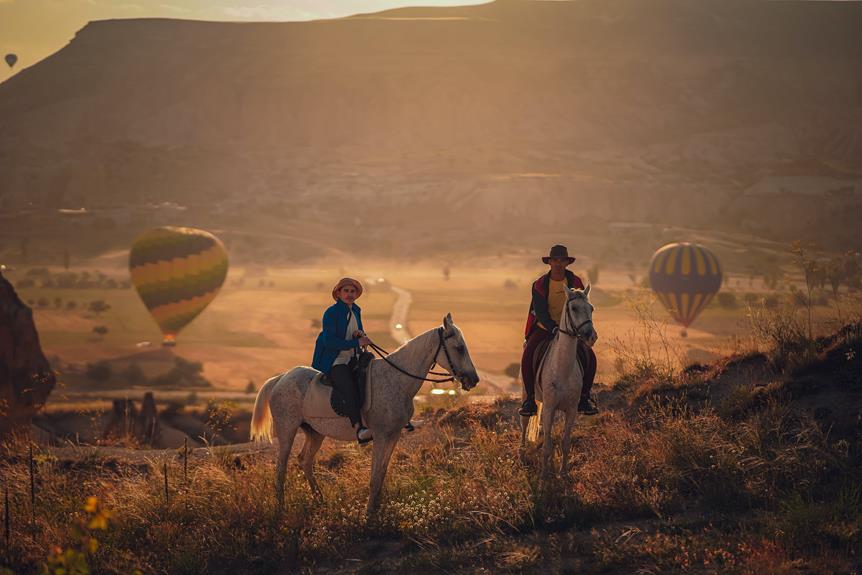Imagine stepping into a world where words are replaced by a silent symphony of gestures, expressions, and vocalizations. It is a world where powerful yet gentle beings, adorned with manes that cascade like rivers of silk, seek to connect with you.
In this realm, horses possess an innate ability to communicate with humans, bridging the gap between species. But how do they do it? How do horses convey their thoughts, emotions, and desires to us?
Let us embark on a journey to unravel the enigmatic language of equines, and discover the profound ways in which horses communicate with humans.
Key Takeaways
- Understanding equine body language is crucial for effective communication and partnership with horses.
- Paying attention to vocal cues provides valuable information about a horse's well-being and needs.
- Horses use eye contact to establish trust and communicate their emotions.
- Observing a horse's body language and responses during physical interaction provides valuable insights into their emotional state.
Body Language and Gestures
Understanding equine body language and gestures is crucial in effectively communicating and establishing a strong partnership with horses. Horses have a unique way of communicating with humans through their body language.
By observing their head carriage, eyes, and ears, we can gain valuable insights into their emotions and intentions. When a horse's head is held high, it indicates alertness and attentiveness. On the other hand, a lowered head signifies relaxation and contentment.
The position of their ears is also significant. When a horse's ears are forward, it shows interest and curiosity. In contrast, pinned back ears suggest aggression or discomfort.
Additionally, the movement of their tail can reveal their emotional state. A relaxed and loose tail indicates calmness, while a stiffly held tail may indicate tension or agitation.
Vocalizations and Sounds
Horses use vocalizations and sounds to convey their emotions and communicate with humans. Understanding these vocal cues is important for horse owners and trainers to effectively interact with their horses. By reading a horse's vocalizations, humans can gain insight into their emotional state and respond accordingly.
For example, different types of vocalizations such as whinnies, nickers, blows, and squeals can indicate various emotions in horses. Whinnies are often used for greetings or farewells, while nickers express affection. Blows indicate fear or excitement, and squeals can represent a range of emotions.
It's crucial for horse owners and trainers to pay attention to these vocal cues, as they can provide valuable information about the horse's well-being and needs. Additionally, horses may use vocalizations to express negative emotions, such as frustration or pain.
Eye Contact and Expressions
When it comes to horse communication, one important aspect to consider is the power of eye contact and expressions. Understanding how horses use their eyes and facial expressions can help you establish trust and effectively communicate with them. Here are some key points to keep in mind:
- Horses make eye contact to establish trust and communicate their emotions to humans. They use their eyes to convey their feelings, whether it's calmness, fear, or stress.
- A soft, relaxed eye indicates that the horse is calm and comfortable, whereas a wide-eyed, tense expression may signal fear or stress.
- Direct eye contact with a horse can convey respect and establish a connection. However, prolonged, intense eye contact can be perceived as a challenge by the horse.
- Horses may use eye contact to seek reassurance or convey their needs to humans. By paying attention to their eye expressions, you can better understand what the horse wants or needs.
- Research has shown that horses have a wide field of view, with each eye having a different function. The left eye focuses on distant objects, while the right eye is more attuned to close-up details.
Touch and Physical Interaction
To effectively communicate with horses, it's important to understand their use of touch and physical interaction. Recent research has shed new light on how horses use touch to convey their emotions and intentions.
The next step in building a connection with your horse is to take the time to engage in physical contact. When interacting with a horse, pay attention to their body language and responses. For example, if a horse licks and chews while being touched, it's often a sign of relaxation and contentment. On the other hand, if a horse shows the whites of their eyes, pins their ears back, or tenses their head and neck, it may indicate discomfort or anxiety.
Physical interaction can be both positive or negative, depending on the horse's preference and emotional state. Each horse is unique, so it's essential to observe and understand their individual responses. Recent research has demonstrated that horses can develop trust and bond with humans through gentle and consistent physical interaction.
Understanding Equine Emotions
Understanding equine emotions is crucial for effective communication and welfare, as it allows you to interpret their body language and respond to their needs. By paying attention to their behavioral signs, you can gain a better understanding of what the horse is feeling.
Here are some key points to consider:
- Horses communicate their emotions through various ways, including vocalizations, body language, and facial expressions. By observing their ears, mouth, eyes, tail, and overall body movements, you can interpret their emotions and needs.
- The whites of the eyes can indicate fear or stress, while relaxed ears and a soft gaze signify a calm and content horse.
- Horses have a vomeronasal organ, which allows them to detect pheromones and other chemical signals. This organ is involved in the flehmen response, where the horse curls its upper lip to better analyze scents.
- Natural Horsemanship techniques emphasize the importance of understanding equine emotions and building a trusting relationship based on clear communication.
- A relaxed horse is more likely to engage with you and express their emotions in a positive manner. By creating a safe and comfortable environment, you can foster a deeper connection with your horse.
Frequently Asked Questions
What Does It Mean When Horses Talk to You?
When horses talk to you, they use vocal cues and body language to convey their emotions and intentions. It's important to interpret their behavior, build trust, and establish a common language for a strong horse-human relationship and emotional connection.
Do Horses Understand When You Talk to Them?
Horses understand when you talk to them through vocal cues, body language, and understanding tone. They can respond to commands and build trust with you. Through nonverbal communication, reading facial expressions, and bonding through grooming, they learn from human interaction.
How Do Horses View Humans?
Horses view humans through their equine perspective, perceiving body language and forming emotional connections. Building trust and establishing mutual understanding are crucial in overcoming communication barriers. Bonding experiences and nonverbal cues help in establishing rapport.
Can Horses Connect With Humans?
Horses can connect with humans through mutual understanding, nonverbal cues, and emotional bonding. Trust-building exercises, interpreting body language, and establishing an intuitive connection are vital for building a horse-human relationship and bridging the communication gap. Vocal communication also plays a role.
Conclusion
In conclusion, horses have a remarkable ability to communicate with humans through a combination of body language, vocalizations, and visual cues. They can recognize and interpret human facial expressions, gestures, and even understand pointing as a reliable signal.
By understanding their cognitive abilities and communication methods, we can improve their welfare and overall well-being.
It's important to continue studying and learning about horses' communication skills to ensure a strong and positive bond between humans and these magnificent animals.



0 Comments